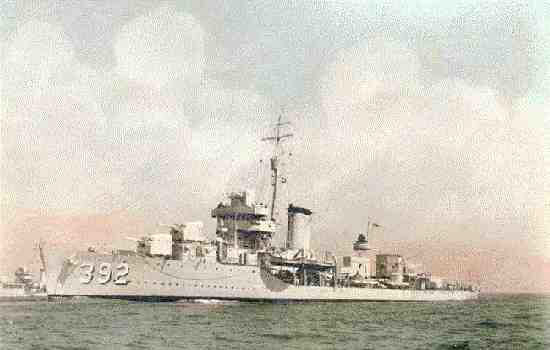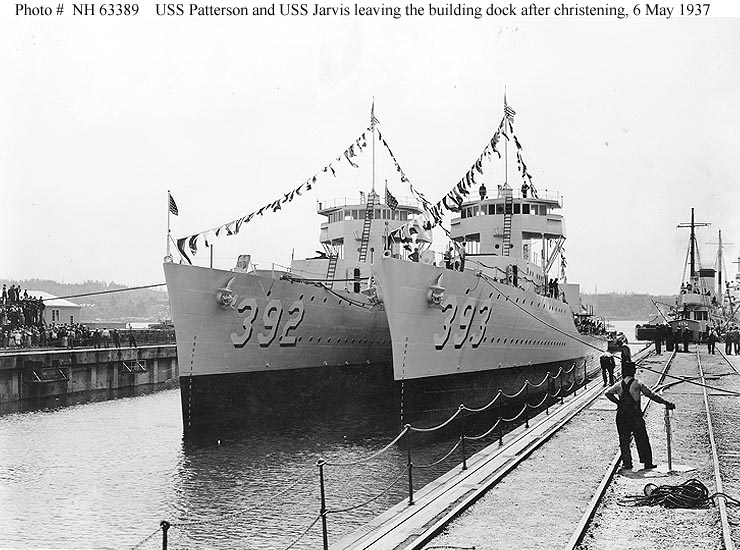|

USS Patterson |
DD-392 |
(Bagley Class) |
| Laid down: |
July 23, 1935 by
Puget Sound Naval Shipyard |
| Launched: |
May 6, 1937 |
| Commissioned: |
September 22, 1937 |
| Decommissioned: |
Decommissioning Party held at the Roosevelt
Hotel, Madison Avenue and 45th Street, New York, New York October 23, 1945 |
| Fate: |
Scrapped, 1947 |
|
| The
Bagley Class as Constructed |
| Displacement: |
1,646 tons |
| Length: |
341 feet, 4 inches |
| Beam: |
35 feet, 6 inches |
| Draught: |
12 feet, 10 inches |
| Performance: |
49,000 shp for 38.5 knots |
| Bunkerage: |
504 tons |
| Range: |
6,500 nautical miles at 12 knots |
| Guns: |
four 5 inch; four .5 inch MG |
| Torpedoes: |
sixteen 21 inch |
DD-392

Above is a picture of the USS Patterson and USS Jarvis leaving the
building dock, 6May1937.

Above is a picture of the USS Patterson, Officers and crew when she was
commissioned. 1937.
The following is transcribed from "THE BLUEJACKET'S
MANUAL" 1943 edition.
Destroyer
"Destroyers have become the all purpose
ships of the Navy. They are a gradual development from the small speed boat, which
was envisioned as the logical torpedo conveyor when the torpedo was invented. The
Japanese made their first surprise attack with the original torpedo boat type upon the
Russians at Port Arthur, commencing hostilities in the Russo-Japanese War. With the
establishment of the torpedo boat, the destroyer was developed, originally termed the
torpedo boat destroyer, resulting in the present type. Destroyers range in
displacement from 1000 to 2500 tons. They do not have as great a cruising radius as
the larger types but are valuable as anti-submarine, anti-aircraft and anti-torpedo
screens for them. Against aircraft and light surface vessels they use their guns,
against heavy surface vessels their torpedoes in night attacks, and against submarines,
depth charges. It is the custom in our Navy to name destroyers for Navy officers and
men who distinguished themselves by heroism or meritorious service in the past. It
is best to learn the destroyers by classes as the total number is so large that individual
ships cannot be easily picked out. In peacetimes they carry large numerals under the
bow on both sides for identification. The destroyer classes are:
| World War Flush Deckers |
117 ships |
| Farragut class |
8 ships |
| Porter class |
8 ships |
| Mahan class |
14 ships |
| Somers class |
5 ships |
| Craven class |
10 ships |
| Fanning class |
2 ships |
| McCall class |
12 ships |
| Sims class |
13 ships |
| Benson class |
24 ships |
| Bristol class |
72 ships |
| Fletcher class |
119 ships |
| Watson class |
2 ships |
Many of the old flush-deck destroyers have been converted to
auxiliary use, generally the conversion considerably altering their appearance. They
usually have only two of the original four stacks, and deck space formerly occupied by
torpedo tubes is made over to accommodate features particular to their type as converted.
Among the converted types are: seaplane tenders, high speed marine transports,
high-speed minelayers and high-speed minesweepers."


|
